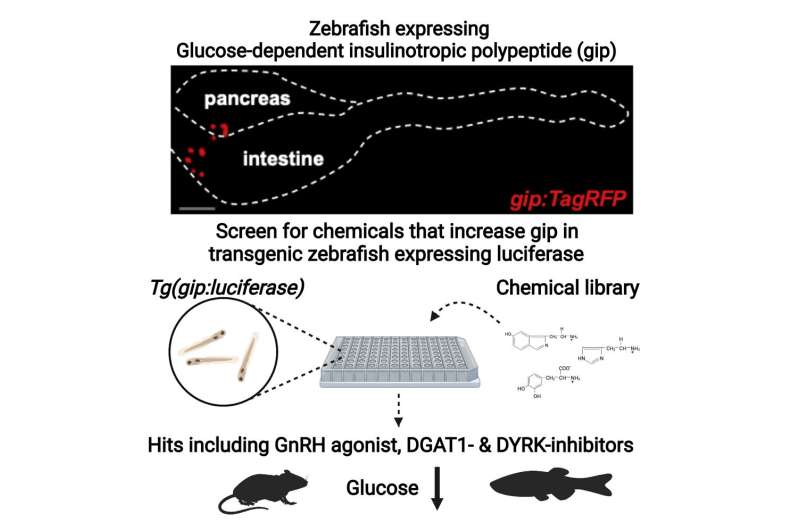Graphical abstract. Credit: Cell Chemical Biology (2022). DOI: 10.1016/j.chembiol.2022.08.001
A new study published in Cell Chemical Biology describes an alternative approach to treat diabetes by identifying drugs directly increasing the number of incretin-expressing cells. The work results from researchers at Karolinska Institutet.
"We have previously performed unbiased small molecule screens for novel potential ways of treating diabetes by targeting the insulin-producing beta-cells. However, what I think is exciting with this work is that we leveraged our unique in vivo drug-discovery approach to a different organ and enteroendocrine cells, which also have the potential to improve management of diabetes," says principal researcher Olov Andersson from the Department of Cell and Molecular Biology.
Hormones released from the gut have important roles in modulating satiety, insulin secretion and blood glucose levels. Of relevance to diabetes, the incretins are hormones secreted upon food intake to enhance insulin secretion and reduce blood glucose levels. There are two different incretins that are called GIP and GLP-1. To identify small molecules that directly increase the number of incretin-expressing cells, the researchers established a high-throughput in vivo chemical screen by measuring the amount of GIP in zebrafish. Several of the identified drug candidates increase the number of incretin-expressing cells and improve glucose control in both zebrafish and diabetic mice.
Developing therapeutics that increase the number of enteroendocrine cells, rather than using analogs of the hormones themselves, is an attractive approach because the hormones can be secreted in a physiological manner. Moreover, in this study, the researchers leverage the screening potential in zebrafish and put forward a concept in which small molecules may broadly reinforce the enteroendocrine system, with possible implications for metabolic disease.
To identify small molecules that increase the number of incretin-expressing cells, the researchers established a high-throughput in vivo chemical screen by using the gip promoter to drive the expression of luciferase in zebrafish. The zebrafish model is ideal for in vivo drug discovery, combining the high throughput of in vitro screens with the physiological complexity and relevance of animal studies. They identified several hits, one of which was particularly efficient in increasing the number of incretin-expressing cells in both zebrafish and mice.
The researchers will now continue to examine whether the hits also work in human gut organoids (a sort of mini-organ that can be grown in cell culture). Moreover, future studies may extend to studying insulin secretion, incretin effect, various mouse models of diabetes, tissue-specific mutagenesis, and human cells/tissues. Overall, increasing the number of enteroendocrine cells is an understudied area that has yet to be explored therapeutically.
More information: Lianhe Chu et al, In vivo drug discovery for increasing incretin-expressing cells identifies DYRK inhibitors that reinforce the enteroendocrine system, Cell Chemical Biology (2022). DOI: 10.1016/j.chembiol.2022.08.001
Journal information: Cell Chemical Biology
Provided by Karolinska Institutet























